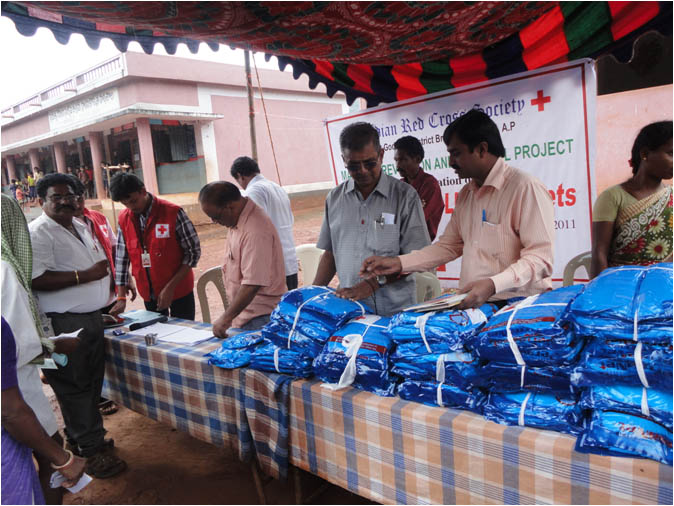
Distribution of nets to the community
World Malaria Day
April 25, around the world is observed as the World Malaria Day to commemorate the global efforts undertaken to control the disease as well as to strengthen our commitment to lead the world towards the achievement of the 6th Goal of the Millennium Development Goal( Combat HIV/ Aids, Malaria and other diseases) and other related MDG’S such as Child Mortality. The Theme for World Malaria Day 2012 is “Sustain Gains, Save Lives: Invest in Malaria".
Global Reports:
Malaria is preventable and curable. Increased malaria prevention and control measures are dramatically reducing malaria in many places. According to the World Malaria Report 2011, of the World Health Organisation , there were about 216 million cases of malaria (with an uncertainty range of 149 million to 274 million). Malaria mortality rates have fallen by more than 25% globally since 2000, and by 33% in the WHO African Region.
Indian Scenario
India accounts for approximately two thirds of the confirmed cases reported in the south-east Asia region. In 2008, 96 million slides were examined, from which 1.5 million cases were confirmed. The number of cases has fallen from more than 2 million confirmed in 2000 to 1.5 million cases in 2008. Five states account for 60% of cases: Orissa, Chhattisgarh, Madhya Pradesh, Jharkhand and West Bengal. Other highly endemic states include Arunachal Pradesh, Assam, Meghalaya and Tripura. (World Malaria Report, WHO, 2009). India has developed a powerful new malaria drug – an alternative to the global drug of choice Artemisinin. The new drug’s raw material is synthetic (derived chemically in the lab) which contains a combination of Arterolane and Piperaquine. This promises to be a major boost to India’s pharmaceutical research. (Times of India, April 24th, 2012).
Indian Red Cross Society Activities
The Indian Red Cross supported by the International Federation of the Red Cross and Red Crescent Societies in 2010-11 had implemented the Malaria Prevention and Control Programme in the two high malaria prevalence districts of Andhra Pradesh( East Godavari & Vishakhapatnam). and Odisha( Koraput & Nayangarh). The objectives of the programme were to prevent malaria by the distribution of 40,000 LLIN (Long Lasting Insecticidal Nets)in two states and supplement government efforts by dissemination of knowledge about malaria and raising awareness especially at the community level.
Indian Red Cross volunteers and members help in educating general public, community leaders and families about the importance of preventing and controlling Malaria in the 4 identified districts of Odisha and Andhra Pradesh. The main strength of this programme lies with the committed volunteers and members of the Junior and Youth Red Cross who communicate essential information needed by the poor and vulnerable to ensure that the interventions are effective.
Volunteers reach out to the vulnerable in high prevalence areas. Red Cross Volunteers are trained under this programme for the distribution and demonstration of LLINs (Long Lasting Insecticidal Nets). Visits to households, engaging in interactive sessions with the community members about health & hygiene, information about early detection signs and symptoms, protective measures including the use of guppi fish and larvicidal oils and educating the community with adequate knowledge regarding Malaria are some of the indispensable efforts undertaken by the Indian Red Cross volunteers towards the global commitment for eradication of the disease.
In Andhra Pradesh 19,800 LLIN has been distributed in the targeted communities/households. Around 16,389 people have been reached through outreach activities and dissemination of IEC material. In Odisha 11,850 families have been targeted.
References:
- Global Reports: World Health Organisation.( World Malaria Report, 2011)
Roll back Malaria Partnership.
- Indian Scenario
World Health Organisation( World Malaria Report 2009).
Times of India, 24TH April, 2012.
- Indian Red Cross Action- Reports from the State Branches.
Consolidated Report of the Malaria Prevention & Control Programme.